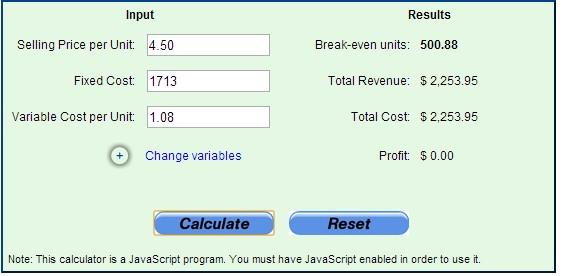Fellow cookiepreneurs, the holidays are upon us, and I hope this month’s post finds you in high spirits and looking forward to the coming days.
Before I begin, I wanted to share that I recently received feedback that some of you would be better served if I broke down the subject matter of pricing into more manageable sections. It is in that spirit that I have decided to extend this costing/pricing subject into a three-part series.
The series will unfold as follows: Part I - Setting up a Successful Costing Model, which was covered in my last post; Part II - Indirect Costs and Break-Even Point; and Part III - Margin and Markup, aka How to Price Your Cookies for Profit.
In this post, I will take you through the process of figuring out your indirect costs and then explain how to use an online calculator to determine your break-even point, or the number of cookies you need to sell in a given month to break even (i.e., neither make nor lose any money). In Part III, I will explain the difference between margin and markup and provide you with two more calculators that will make it a breeze to price your cookies for profit.
Last time, you learned how to compute the direct costs associated with producing a cookie, and that direct costs only involve those raw materials, packaging, and labor that go into the creation of your product. In order for you to accurately price your cookies for profit, you will need to figure out your indirect or overhead costs and take them into account as well. Overhead or indirect costs can best be defined as the expenses related to the running of a business such as rent, utilities, or any other costs not associated with the direct materials or labor used to manufacture your product. (For a refresher on how to compute your direct costs, please revisit my previous post.)
As an example here, I will build upon my average direct costs of $1.08 per unit (for relatively simple decorated cookies) by computing my average indirect costs. You should, of course, develop your own unique costing model that reflects the average direct costs of your cookies and the indirect costs associated with your business structure (i.e., home-based, standalone shop, etc.). For instance, your direct costs could very well be much higher than mine if you do detailed labor-intensive cookie designs.
1.0 Indirect Costs/Overhead - How Much Does It Cost You To Run Your Business?
That said, your overhead can vary from month to month depending on the number of cookies you produce, and if you have any payments that are not monthly, but which are paid on a quarterly basis or at some other frequency. To keep this analysis simple, I've computed an average monthly overhead, which I am treating as 100 percent fixed (meaning I have assumed that any fluctuations in my variable costs are small and any "lumpy" fixed costs have been spread out over the year.)
Below I have provided a sample of the monthly costs associated with running Wacky Cookies, my cookie operation. I use a spreadsheet that allows me to create a projected budget and then adjust for actual costs. I have taken into consideration rent, phone, utilities, advertising, insurance, gas, supplies, and wages. Please note that these wages are for indirect clerical and cleaning services and should not be confused with direct labor costs for which I have already accounted.
Although not reflected in this particular budget, licensing fees or fees for professional services rendered, such as accounting or legal consultations, should be added if incurred. For a more complete list of which expenses to include as part of your overhead, refer to 1040 Schedule C.
If you include your earnings from your home-based business on your annual 1040 and operate as a sole proprietor, consult irs.gov for guidance on how to accurately calculate/pro-rate rent and other expenses (such as utilities) for the sections of your home used for your business. This is how to determine what you can deduct for business-related expenses.
If you run any kind of corporation or your tax questions extend beyond these basics, it's best to contact a certified tax/accounting professional for further guidance, as the way you set up your expenses and bookkeeping has a direct bearing on your tax liabilities.
With my average direct and overhead costs now figured out, I have the two figures, along with cookie price, needed to arrive at my break-even point.
2.0 Break-Even Point
What is a break-even point and why is it so important? As noted earlier, your break-even point is the number of cookies you need to sell in a given month (or other period) so as not to make or lose a dime.
I wanted to pause on this point before moving onto pricing in Part III, because many of you are already selling cookies and have set your prices. With what you have learned in Parts I and II and your own prices and costs now in hand, you can easily calculate your break-even point with the following Break-Even Analysis Calculator designed by the good folks at CCD Consultants.

Source: Table and Break-Even Analysis Calculator by CCD Consultants
You can certainly set up a break-even calculation in your own spreadsheet (Breakeven Units per Month = Monthly Fixed Costs/[Price per Unit - Variable Cost per Unit]), but CCD Consultants has a number of other handy tools that we will use to calculate other important figures in our next post. Their tools are free of charge, however donations are accepted for their use.
Here's a quick overview of how their Break-Even Analysis Calculator works, using my example. Simply plug in three numbers to the left:
- $4.50 is my average price per cookie
- $1,713 is my average monthly overhead
- $1.08 is my average direct cost per cookie - what I figured out in Part I (Here, you would also want to include any variable indirect costs if they are significant in your case. As noted earlier, I have treated all of my indirect costs as fixed.)
Then at the push of a button, the calculator indicates that to break even or make no profit, I need to sell 501 cookies each month, which comes to $2253.95 in revenue at a $4.50 selling price.
Now that you have access to this tool, I encourage you to use it, and I ask:
At your current price, how many cookies do you need to sell per month to break even?
Even though we have not yet reviewed pricing and profit margins, I hope that by simply looking at these figures, you will gain more perspective on what you should be charging and why.
Again, next time around, we will discuss the difference between margin and markup, and finally how to price your cookies for profit.
As always, I welcome your comments and questions. For those here in the States, I wish you a wonderful Thanksgiving packed with blessings, turkey, stuffing, and lots and lots of cookies. And, of course, warm holiday greetings to all!
Always remember, persistence is the key to success, Never give up, never!

Aymee VanDyke, also known as Cookiepreneur, is a successful entrepreneur and business consultant whose main focus is to help women in the cottage food industry build profitable and rewarding businesses. She is the founder and owner of Cookiepreneur and The Wacky Cookie Company, a four-year-old cottage/commercial cookie business that has operated in the black for most of its existence. Aymee has an extensive background in personal development and attended the Norwegian School of Business in Oslo. Her articles have been published in BISSI, the magazine of the Norwegian School of Business, and Somos Magazine.
Photo credit: Aymee VanDyke
Note: From Dough to Dollars is a regular Cookie Connection blog feature written by Aymee VanDyke that provides business planning, marketing, and other tips for starting a cottage cookie business and taking it to the next level. Its content expresses the views of the author and interviewees, and not necessarily those of this site, its owners, its administrators, or its employees. To catch up on all of Aymee's past posts, click here.





Comments (15)